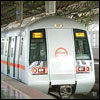When Metro Man Dr. E. Sreedharan proposed using sand from the Periyar and Bharathapuzha rivers for the works of the Kochi Metro Rail project, hardly did he anticipate that the proposal primarily made with a view to ensuring strength and durability of the metro rail structures would trigger a major controversy.
Dr. Sreedharan, in his role as the Principal Advisor of Delhi Metro Rail Corporation for the Kochi Metro Rail project, had placed the proposal for using sand from the Periyar and Bharathapuzha rivers, one known as the Lifeline of Kerala and the other as Nile of Kerala, before the state government. The sand from both rivers is considered to be of high quality.
The Kochi Metro Rail project requires four lakh cubic meter sand. Environmentalists argue that sand mining in the two rivers for such a huge quantity of sand would have disastrous consequences.
 In February last year, the Supreme Court had directed that leases of minor mineral including their renewal for an area of less than five ha be granted by states/UTs only after getting environmental clearance from the Ministry of Environment and Forests. In order to ensure compliance with the Supreme Court order, a circular was subsequently issued by the MoEF on May 18th, 2012, stating that all mining projects of minor minerals including their renewal, irrespective of the size of the lease, would require prior environment clearance. Mining projects with lease area up to less than 50 ha including projects of minor mineral with lease area less than 5 ha would be treated as category ‘B’ as defined in the Environment Impact Assessment notification, 2006, and considered by the respective State Environment Impact Assessment Authority notified by MoEF following the procedure prescribed under EIA notification, 2006, the circular said.
In February last year, the Supreme Court had directed that leases of minor mineral including their renewal for an area of less than five ha be granted by states/UTs only after getting environmental clearance from the Ministry of Environment and Forests. In order to ensure compliance with the Supreme Court order, a circular was subsequently issued by the MoEF on May 18th, 2012, stating that all mining projects of minor minerals including their renewal, irrespective of the size of the lease, would require prior environment clearance. Mining projects with lease area up to less than 50 ha including projects of minor mineral with lease area less than 5 ha would be treated as category ‘B’ as defined in the Environment Impact Assessment notification, 2006, and considered by the respective State Environment Impact Assessment Authority notified by MoEF following the procedure prescribed under EIA notification, 2006, the circular said.
The National Green Tribunal had passed an order in August this year restraining any mining activity or removal of sand from river beds anywhere in the country without first obtaining environmental clearance from the MoEF/SEIAA and license from competent authorities.
“Both Periyar and Bharathapuzha rivers are already very badly impacted due to rampant legal as well as illegal sand mining,” Dr. C.M. Joy, executive committee member of the Kerala-based Association for Environmental Protection, an NGO engaged in several areas including river protection, told Projectmonitor.
“As a result of large scale sand mining over the years, the banks of both rivers have begun eroding and the middle portion is getting deeper and deeper. The impact of sand mining in the two rivers is already being felt by the people. There is drinking water shortage due to falling ground water levels and increase in salinity in the water supplied. The agricultural and industrial sectors are facing the consequences as well. Even electricity production is impacted. The bridges across the two rivers are under threat as the base sections of their pillars have been bared as a result of indiscriminate sand mining. Any more mining in the two rivers is bound to make the situation worse with long-term consequences,” he added.
Dr. Joy disagreed with the view that sand from the two rivers was of high quality.
“In the last 10-20 years, huge quantities of sand had been extracted daily from Periyar. Today, very little sand is left in the river. The quality of whatever little is left is not the same as before,” he said.
Dr. Joy suggested that sand for the Kochi Metro Rail project be sourced from countries such as Cambodia.
Meanwhile, at the review meeting of the Kochi Metro Rail project held last month, it was decided to allow sand mining from the Periyar and Bharathapuzha rivers. The final decision would be taken by the cabinet.











